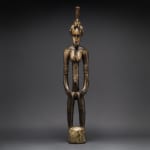Female Senufo Wooden Pombilele Rhythm Pounder, 20th Century CE
Wood
height 99.1 cm
height 39 in
height 39 in
PF.5843 (LSO)
Further images
This elegant piece is one of the most exceptional pombilele sculptures we have seen. Made by the Senufo group of Mali, it is associated with the secret Poro society (see...
This elegant piece is one of the most exceptional pombilele sculptures we have seen. Made by the Senufo group of Mali, it is associated with the secret Poro society (see below) and has a sculptural quality that transcends utilitarianism. The base is a belted column with a central relief flange projecting perpendicular to the long axis of the piece. The legs are short with defined knees – unusually – and an extremely ornate and well-defined trefoil loincloth decorated with hatched and geometric patterns. The torso is elongated with a prominent abdomen, and prominent, pointed breasts. The arms are also long, the upper aspect of which are twice as long as the forearms. The neck is elongated and columnar, supporting a long head with a concave jawline extending to a pointed chin. The nose is long and curved, with forward-thrust jaw and lips. The ears are triangular and rear-pointing, and the domes head is surmounted by a four-part crest that bears a passing resemblance to a bird in flight. The sculpture is more detailed than is usual, with scarifications around the prominent navel and beside the eyes.
The Senufo group, based in the Ivory Coast and Mali area, has a long history of using highly decorated objects in many aspects of everyday life. However, their extremely high level of skill in woodcarving is nowhere better seen than in the realm of their magical-religious art. At the heart of Senufo society is a patriarchal groups of elders known as the Poro society, which is responsible for many religious and more urbane functions to do with the running of the tribal group. Their ceremonial events are often associated with dancing, music and the use of Pombilele sculptures.
“Pombilele” literally translates as “those who give birth”, and traditionally constitute a pair of figures (one male, one female) who represent primordial humanity and the ancestry of all humankind. Most examples, however, are of single, female figures. The appearance of these figures is relatively homogenous, being tall, slim and somewhat angular. However, the personal characteristics of each sculpture were often based upon a dream or vision by a Poro elder. There is also some social and geographic variability. The figures were used as pounding devices (holding each arm) to keep the rhythm for dancing, or were stood for purposes of contemplation in the middle of the Poro society’s sacred enclosures. They are also used for the interment of prominent Poro members; they are carried to the graveside with the dead body, then used to tamp down the earth on top of the grave, to ensure that the spirit of the dead is directed to the afterlife rather than returning to haunt the living.
This is a striking and attractive piece of African art.
The Senufo group, based in the Ivory Coast and Mali area, has a long history of using highly decorated objects in many aspects of everyday life. However, their extremely high level of skill in woodcarving is nowhere better seen than in the realm of their magical-religious art. At the heart of Senufo society is a patriarchal groups of elders known as the Poro society, which is responsible for many religious and more urbane functions to do with the running of the tribal group. Their ceremonial events are often associated with dancing, music and the use of Pombilele sculptures.
“Pombilele” literally translates as “those who give birth”, and traditionally constitute a pair of figures (one male, one female) who represent primordial humanity and the ancestry of all humankind. Most examples, however, are of single, female figures. The appearance of these figures is relatively homogenous, being tall, slim and somewhat angular. However, the personal characteristics of each sculpture were often based upon a dream or vision by a Poro elder. There is also some social and geographic variability. The figures were used as pounding devices (holding each arm) to keep the rhythm for dancing, or were stood for purposes of contemplation in the middle of the Poro society’s sacred enclosures. They are also used for the interment of prominent Poro members; they are carried to the graveside with the dead body, then used to tamp down the earth on top of the grave, to ensure that the spirit of the dead is directed to the afterlife rather than returning to haunt the living.
This is a striking and attractive piece of African art.







